As the RFI Teams prepare to be trained and receive the equipment purchased with the $23.6K ARDC grant, additional team members are sought in ME, VT and RI. Training and distribution of equipment will occur in early 2023. This is an opportunity to help your friends and your club and learn something new with some very sophisticated equipment. You can see who has already volunteered on the New England RFI Team page. If you’d like to see your name and callsign on the team page, please contact your section team lead listed on the page. RFI is a major concern for all hams and the knowledge you receive will help you and help others. For more information, please email me at k1ui@nediv.arrl.org.
Month: December 2022
Foxhunt, South Windsor CT, New Years Day 2023
Paul, N1TUP
Youth On The Air Camp 2023 Application Period Now Open
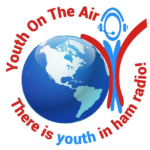 Applications are now being accepted for campers interested in attending Youth on the Air (YOTA) Camp 2023.
Applications are now being accepted for campers interested in attending Youth on the Air (YOTA) Camp 2023.
Licensed amateur radio operators ages 15 through 25 are encouraged to apply online at YouthOnTheAir.org. The Radio Amateurs of Canada will be the local host for the 2023 YOTA Camp. It is scheduled to take place July 16 â 21, 2023, at the Carleton University campus in Ottawa, Ontario, Canada.
Applications will be accepted through May 31, 2023, but for the best chance at being selected, applications should be submitted by 2359 UTC on January 15, 2023.
The application process is free. However, a $100 deposit is required upon acceptance. If a camper is unable to pay the deposit, they may be able to apply for a scholarship or waiver. Camp Director, Neil Rapp, WB9VPG, said campers are responsible for their transportation to the camp location, though some assistance may be available. Travel during camp events is provided. [Full story]
Amateur Radio Operators Using DMR Assist in NH rescue
From New Hampshire ARRL Members Only list:
“When all else fails, Amateur Radio” proved to be more than just the ARRL tagline on Sunday December 11, 2022.
An elderly New Hampshire man went out for a day hike with his dog yesterday in the Belmont area of central New Hampshire. Things went well, until his cellphone battery died. With the oncoming snow and darkness, a leisurely day hike was quickly turning into a serious health and safety issue for the hiker.
Fortunately for him he is also an amateur radio operator and had his DMR HT with him. With no cell phone capability, he made a call on a DMR NH statewide channel through the Gunstock DMR repeater seeking assistance.
His call was answered by Bill Barber, NE1B who was monitoring the channel. The hiker asked Bill to call his wife as he could not text or get pinged with his dead cell phone. Bill contacted the hiker/ham’s wife, and she was glad to hear that someone was in contact with him.
Unfortunately, he did not know exactly where he was and believed he would have to walk through brush for an hour or more to get to a road.
His wife called in the local police department who began a search along with their FD.
Ham radio was the only communication from about 4:30 to 6:30 PM. Bill called up Rick Zach, K1RJZ, who lives closer to the search area, and he was familiar with the area snow mobile trails and roads. Rick coordinated communication between the responding police units and the lost ham on the NH Statewide talk group.
The police and fire units attempted to assist in the search by activating their sirens in different locations to try to obtain a location on the ham, however, he was not able to hear them.
Another ham, Chuck Cunningham, K1MIZ, was monitoring the events on net watch and noticed that the lost ham had accidentally changed channels.
This information was passed along and 2 meter DMR communication continued until the lost ham walked out to a road and could advise where he was. The search and checkout ended successfully at 6:30 PM.
Thanks to the efforts of Bill, NE1B, Rich, K1RJZ and Chuck, K1MIZ the wayward ham is going to be able to enjoy another Christmas holiday with his family.
Bill listed some very important lessons learned from the incident:
- Radio batteries last longer on DMR radios than on analog mode
- Even his wife had trouble on her cell phone coverage at home
- Monitor your local State DMR channel for helping others nearby
- You may want to program 146.52 FM next to your State channel for signal strength DFing if and when out of repeater range
- Some hams still monitor 52!
- But stay on the primary channel until you know more hams are nearby to DF
- Hike with DMR. Our network sites cover many areas of New England that do not have any cell service
- Hike with a flashlight
And I would like to add one more item to the list. My son is one of the leaders of Pemi Search & Rescue and unfortunately responds to too many calls for lost hikers. One very important item that he stresses is that hikers file a “flight plan.” Let someone who is not going on the hike know where you are going, how long you expect to be gone and what communication equipment or capability you have with you. This also applies if you are going out hunting, fishing or boating.
Raul “Skip” Camejo – AC1LC
Public Information Coordinator
ARRL New Hampshire Section
CT Section News, December 2022
 Betsey M Doane, K1EIC, writes on CT ARRL Members list:
Betsey M Doane, K1EIC, writes on CT ARRL Members list:
Happy holidays and happy first significant snow of the year. Do be careful and stay safe. Many thanks to EC Sky Warn Ed W1YSM for keeping us up-to-date on the latest news from NWS.
I wrote previously to tell you that our immediate past SEC George Lillenstein AB1GL became a silent key. There will be a service via Zoom on Wednesday, December 14, at 4:30 PM EST. George’s family is in northern Kentucky and near Cincinnati, Ohio. If you would like to attend, please join Zoom meeting: https://us02web.zoom.us/j/85221021153?pwd=N0NZeUp2cjZGM09oTDBTSVdaOFZsQT09 Wednesday, December 14 at 4:30 p.m. Meeting ID: 852 2102 1153 Passcode: lillen
George was an example to us all because he was involved in so many different aspects of Amateur radio. Among them were The Newington Amateur Radio League, The Bears of Manchester, NCS on NTS nets, mentor, Division cabinet meetings, District Emergency Coordinator for many years and then Section Emergency Coordinator, various communications activities including the Manchester Road Race for 20 years and took various club officer posts including club president. His activities remind us all to stretch ourselves and learn something new—there’s so much to do in this wonderful hobby we enjoy.
We have unfortunately lost other wonderful members of our field organization, Jim Ritterbusch KD1YV also a past SEC, and Art Fregeau AF1HS, Assistant SEC and one who ran our web site for so many years. Jim was a past Division volunteer of the year and past president of the Candlewood Amateur Radio Association. Art maintained the ARES database and the CTARES.org web site for over 20 years. You knew when Art was at a hamfest when you saw that van with all the antennas up top—he loved his radios and scanners! May George, Jim and Art rest in peace. Each was a gift to us all.
It was a pleasure for me to attend the Christmas party at the Candlewood Amateur Radio Association where I was pleased to spend time with longtime friends, new ops and even one who was waiting for his call sign. Remember those days? Wasns’t it exciting when your call arrived?
Congrats to Barb K1EIR who has just been appointed by Governor Lamont to the State Independent Living Council. This involved several interviews. Good luck Barb—k1eir@arrl.net!
The new year is upon us and we’ll need to get serious about recruiting anew full-time Section manager. If you’re wondering about the field organization, what it is, what it does and what a Section Manager does, check out the material on the ARRL Web site. You can also go to the CT Section page where there is a PowerPoint presentation with audio that I did many years ago. It’s somewhat dated but you’ll get the idea. Of course, just write and ask. We’ll talk more about it in the new year.
I wish for each of you a wonderful holiday season. Stay well and safe.
——————————————————————–
ARRL Connecticut Section
Section Manager: Betsey M Doane, K1EIC
k1eic@arrl.org
——————————————————————–
Boston Marathon Registration Opens December 5, 2022
Volunteer registration for the 2023 Boston Marathon opens today. Returning volunteers will get an email from the BAA later this morning with instructions. In order to make registration as smooth as possible we are providing specific instructions for our Amateur Radio Operator (ARO) volunteers.
If you haven’t previously volunteered, or have a friend who would like to volunteer, please go directly to the Volunteer Registration page after 10:00 AM EST and follow the instructions for new volunteers.
Step by Step Sign Up Guide:
https://hamradioboston.freshdesk.com/en/support/solutions/articles/44002389087-2023-volunteer-registration-step-by-step-guide
A few notes for volunteers:
Almost all amateur radio positions are single person assignments. We are not able to group people on a single assignment, but we will try to accommodate which segment you are assigned to in order to allow for similar start/end times.
Don’t delay! Volunteer registration closes on Friday, February 10 at 5:00 PM EST. It would help our planning processes if you could please complete your registration by Friday, January 27.
Help us get the word out by forwarding this email to your club and other amateur radio operators who might wish to volunteer. Most volunteers first learn about the event through word of mouth. If you know new licensees who might like to join us, please make sure to let them know about it. Even just a quick mention at your club meeting can be a big help.
If you have any questions about the upcoming volunteer registration period, or the 2023 Marathon generally, please get in touch anytime. Volunteering at the Marathon is a big job and we appreciate the time and effort everyone puts into it. We’re happy to do what we can to make your work fun, comfortable, and effective.
We look forward to seeing everyone again soon.
Thank you, and 73,
Boston Marathon Communications Committee
contact@HamRadioBoston.org
Next Consortium Meeting, Manville RI, December 5, 2022
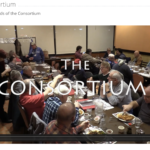 Bob Beaudet, W1YRC, writes:
Bob Beaudet, W1YRC, writes:
Greetings all:
The next Consortium will take place on Monday, Dec 5th at the Manville Sportsman’s Club, 250 High St. in Manville, RI. Our regular presenter, Jim, K1GND, is taking some leave time away from the Consortium to provide care for his wife, Ann who is undergoing some serious medical issues. We were planning on Mike, K1ETA, to present material regarding his extensive portable operating by the sea shore, on hill tops and in the field using QRP and higher power with a variety of home made antennas. However, Mike came down with some serious congestion and other cold related problems.
So, you will be treated with some operating conversation related to DXing from W1YRC over my time as a DXer starting in about 1962. Operating tips, QSL tips and various operating awards available will be covered. This will be a conversational style presentation, so bring your favorite questions and stories. Keep in mind that the purpose we serve in the Consortium is to cover basics with the goal of helping new hams and others to improve their knowledge of ham radio topics.
Thank you and see you at the Consortium. We plan to start about 7:00 PM.
73, Bob, W1YRC
[See also: The Consortium—Covering the Ham Radio Basics]—
Greetings all for the second time:I have a last minute program change that will make the presentation more interesting than it would be as I planned it.Ken Trudel, N1RGK, offered to present a follow-up to his original 2019 program concerning preparation of coaxial connectors for outdoor service. In his latest program, Ken shows how weather has affected his coaxial connectors over the three years since being installed. He has actual hardware to show and documentation.I will go first at 7:00 and Ken will follow at about 7:30–7:45.Thanks and see you at the Consortium.73, Bob W1YRC
Merrimack Valley Amateur Radio Association (NH) Off to a Great Start!
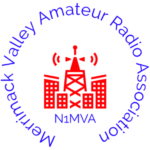 The Merrimack Valley Amateur Radio Association (call sign N1MVA) was formed in August 2022 by eight NH ARES members. ARES is a program, not an entity that could own equipment or fundraise. Our goal is to establish the MVARA as an organization that may own equipment and fundraise to support the emergency communication mission. The MVARA is a registered NH nonprofit corporation and a federal 501(c)3 charitable organization, and is registered with Amazon Smile. The MVARA has been accepted as an ARRL affiliated club. Current membership is 22 with 91% being ARRL members.
The Merrimack Valley Amateur Radio Association (call sign N1MVA) was formed in August 2022 by eight NH ARES members. ARES is a program, not an entity that could own equipment or fundraise. Our goal is to establish the MVARA as an organization that may own equipment and fundraise to support the emergency communication mission. The MVARA is a registered NH nonprofit corporation and a federal 501(c)3 charitable organization, and is registered with Amazon Smile. The MVARA has been accepted as an ARRL affiliated club. Current membership is 22 with 91% being ARRL members.
Our current focus is collaborating with the New England Digital Emergency Communications Network to interconnect DMR sites with microwave radio links. The microwave links backup internet connections when the internet is disrupted, thereby making the DMR system more resilient for routine and emergency communication. Presence on the towers also extends our microwave network. The first installation is a link between the Crotched Mt DMR site, which lost internet when the provider discontinued service to the area, and the South Uncanoonuc DMR site which has a pre-existing 5GHz link to the internet at the Bow, NH DMR site. DMR traffic flow can be evaluated from the repeater to the new Part 97 AREDN 5GHz link, then to the pre-existing Part 15 Ubiquiti link, and finally to the internet. The link has been operational since early October with only one occasionally recurring issue that can be corrected remotely. Its cause remains to be identified, part of our learning curve.
The main activity planned for next year is writing a proposal to ARDC for funding to expand the microwave backbone among DMR repeater sites within the context of the New England Division mesh network project. The backbone and network services would provide opportunities for other licensed operators who may wish to use the microwave network for various amateur radio purposes.
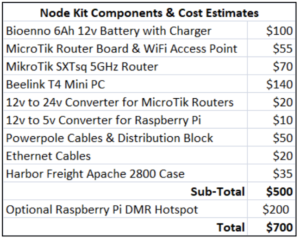 There is a possibility of developing a STEM module about microwave IP networking. Lessons could be introduced with familiar microwave radios – cell phones and computer wifi – followed by modern battery technology, microwave and IP basics, and culminated by setting up a local microwave connection. Portable battery-powered microwave node kits – designed under Part 15 compliance for unlicensed use in school classrooms or Part 97 compliance for amateur radio use – are easily assembled with off-the-shelf components and deployed for demonstration and instruction. Kits can also be used as portable nodes for emergency and event communications.
There is a possibility of developing a STEM module about microwave IP networking. Lessons could be introduced with familiar microwave radios – cell phones and computer wifi – followed by modern battery technology, microwave and IP basics, and culminated by setting up a local microwave connection. Portable battery-powered microwave node kits – designed under Part 15 compliance for unlicensed use in school classrooms or Part 97 compliance for amateur radio use – are easily assembled with off-the-shelf components and deployed for demonstration and instruction. Kits can also be used as portable nodes for emergency and event communications.
Components for a portable microwave network node kit are shown in the table and photo. Total cost is about $500 plus shipping, including a Windows Mini PC. The Mini PC can be used to control an HF or a VHF radio remotely over the network for NBEMS, Winlink and popular weak signal modes. A Raspberry Pi could be substituted for the Mini PC if there is no need for Windows software, decreasing cost proportionally.
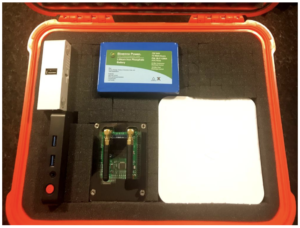
Battery charger, 12v converters and cables are stowed underneath.
Amateur Radio Club Provides Communications Support for Thanksgiving Day Race
From The ARRL Letter, December 1, 2022:
The BEARS of Manchester Amateur Radio Club in Manchester, Connecticut, spent Thanksgiving Day providing amateur radio communications support for the 86th Manchester Road Race.
The race, a 4.748-mile course that begins and ends on Main Street in downtown Manchester, has been a Thanksgiving Day tradition since 1927. This is the 30th consecutive year the BEARS of Manchester Amateur Radio Club has provided communications support, with more than 10,000 runners participating and over 30,000 spectators lining the course.
Radio operators began arriving at 6:00 AM on Thanksgiving morning. Fifty-five operators staffed 39 positions around the course and were stationed every quarter mile to provide safety communications and report the lead male and female runners to the public address announcer.
Shadow operators helped 10 race officials stay in communications. Operators also started and ran four clocks around the course to help pace runners, and a station operated in the public safety Emergency Operations Center (EOC) to relay safety-related information to representatives of various agencies. Ham radio operators also provided communication for a shuttle bus operation that brought runners and spectators from a remote parking area to Main Street and then returned them at the end of the race. Check-in and check-out were accomplished through a net control station to maintain accountability.
Communication for the event was made on six repeater and simplex frequencies, and three cross-band repeaters were used for signal quality to avoid interference.
The BEARS of Manchester Amateur Radio Club is an ARRL Affiliated Club.
Thanks to Phil Crombie, Jr., K1XFC, Race Communications Coordinator, for providing information for this story.
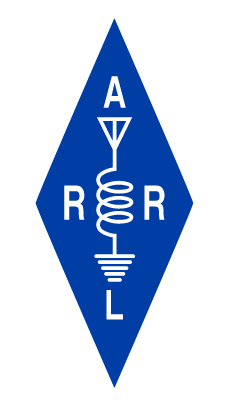
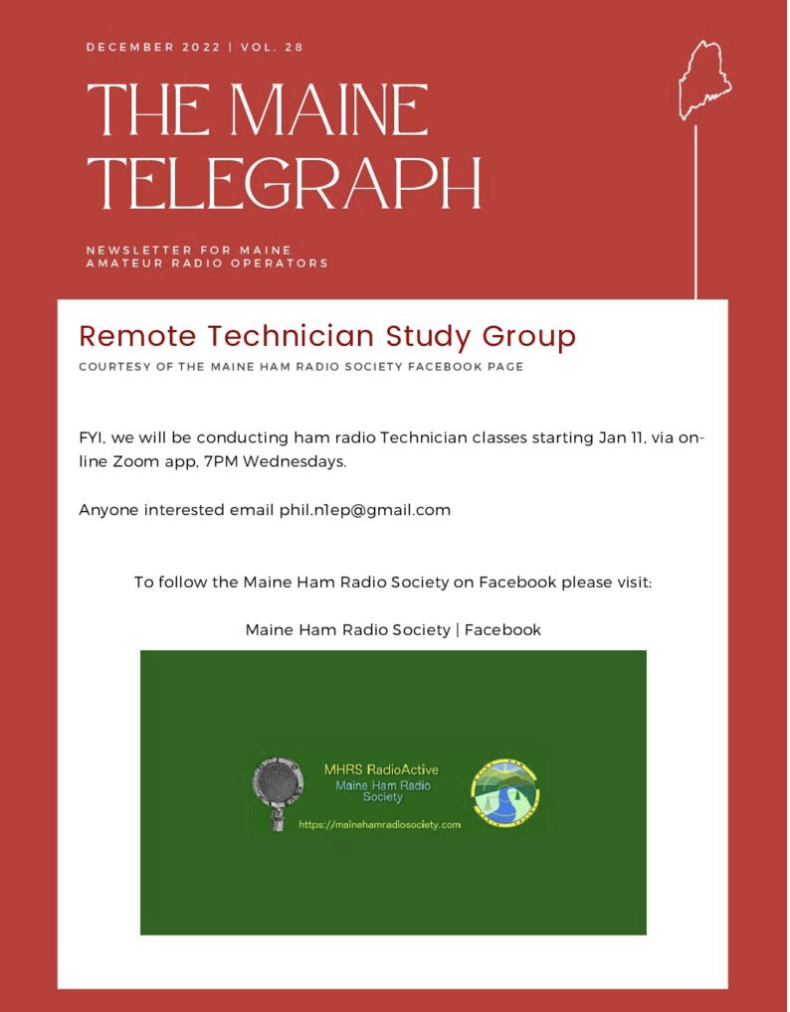 The
The